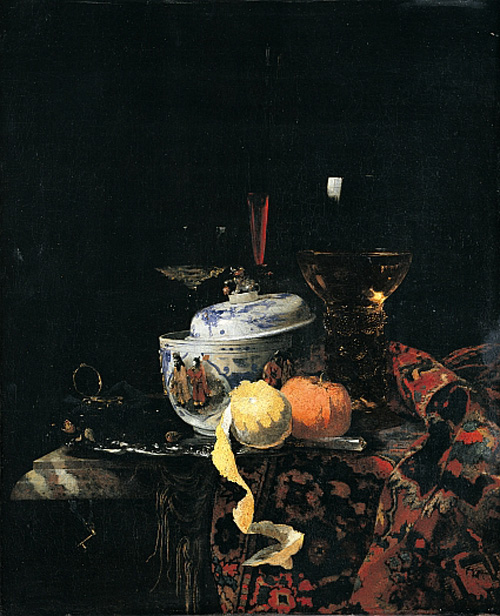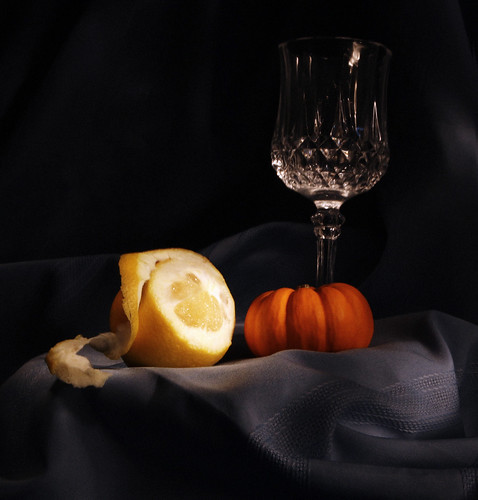The day Ozoz’s package from the Netherlands arrived was a very exciting one, not only because of the delicious caramel cookies but also the beautiful cookbook filled with the things I love. Ozoz writes the food blog Kitchen Butterfly and is one of the most dedicated bloggers I read, posting every other day. She kindly sent me a copy of the cookbook Dutch Culinary Art which she first wrote about on her blog back in December after meeting two of the three writers. The book is filled with traditional recipes introduced by sweet little anecdotes about their origin and history. Dispersed throughout are opulent still lifes and pleasant kitchen scenes. Ozoz’s blog is more than just a record of recipes and culinary delights, she provides useful travel guides as well as everything you would need to know about food before visiting the Netherlands. I only wish I knew about her blog when I lived in the UK and frequented the ‘Orange Country‘ – her affectionate name for the Dutch countryside. Thank you again Ozoz for the beautiful book and for working with me on this collaboration!
Visit Ozoz’s blog Kitchen Butterfly for a recipe for Pumpkin Ice Cream & Lemonettes.

Willem Kalf was a still life painter from the Golden Age of Dutch art. His work usually features the same subjects, a Chinese bowl (the painting above bears the title of this oft replicated object), damask tapestry, and silverware. The paintings contain a very dark background, isolating the objects on the edge of the table. In the Still Life with a Chinese Tureen (1662) the outline of the glass is barely visible, a characteristic of Kalf’s work. Later in his life the artist turned to dealing in art rather than painting. It seemed he always had a business mind because if a composition proved successful he would make multiple versions for clients – perhaps why his body of work is considered to be limited in terms of subject matter.

According to Dutch Culinary Art,
Parrot Tongues are “a typical Dutch joke. Actually just leftovers, but presented in a very nice way. The name, of course, brings memories of Roman times when people feasted on tongues of nightingales and larks.”
These little ‘tongues’ make for a very delicious appetizer. The sweet pork meat is paired with the sweet flesh of a pumpkin and livened up with fresh lemon juice and vinegary seeded mustard.
Papegaaientongetjes (Parrot Tongues)
adapted from Dutch Culinary Art
2 TB softened butter
1 egg
1/2 cup milk
1/2 cup plain flour
1/4 cup pureed roasted pumpkin
1 TB chopped fresh parsley
1/4 tsp nutmeg
pinch of salt
4 cooked pork scotch fillets, cut into triangles
1/2 cup canola oil
With an electric mixer, cream the butter and beat in the egg and milk. Slowly add the pureed pumpkin and flour until a smooth and thick batter forms. Add the nutmeg, parsley and salt to season.
Heat the canola oil in a deep skillet. Once the oil shimmers, dip the pork triangles in the batter and drop into the oil. Because the pork is already cooked the Papegaaientongetjes fry very quickly, 20-30 seconds. Flip and cook the other side golden brown and remove from the oil and dry on kitchen paper.
Serve immediately with a squeeze of fresh lemon and a scattering of chopped parsley.


16 comments
Rosa says:
Feb 23, 2010
A delicious looking dish!
Cheers,
Rosa
Joanne says:
Feb 23, 2010
I love Kitchen Butterfly. She has such an inspiring blog!
This is a delicious looking interpretation of this painting! Pumpkin paired with anything is A-OK in my book, but especially pork, which is my favorite meat. I love the name of this dish! It definitely had me guessing as to what would actually be in it.
Heavenly Housewife says:
Feb 24, 2010
I love Kitchen Butterfly too, she is lovely :).
Love the look of this dish. I am even more intrigued by its name.
*kisses* HH
shaz says:
Feb 24, 2010
GOing to jump on the “me too” bandwagon – really love Oz’s blog :) And what a great name for a dish – would be so cool at a pirate themed party…arrr..
Julie says:
Feb 24, 2010
Megan, your still life recreation is absolutely stunning. You are a genius with staging and lighting.
hungry dog says:
Feb 24, 2010
What an interesting dish! I love the name. As always, your photography impresses me!
deana says:
Feb 24, 2010
Gorgeous gorgeous paintings and photos with great story… Oh I really want to get something for your contest!!!
Feasting on Art, with Pumpkin icecream and Lemonettes | Kitchen Butterfly says:
Feb 24, 2010
[…] I choose sweet…..and Megan, savoury! […]
Kitchen Butterfly says:
Feb 25, 2010
Megan, that composition of yours is superb!!!!!! Wow. You’ve recreated the heaviness and darkness of his painting. Wow….again. I ♥d this collaboration. Thank you for giving me the chance and I’ll have to give papegaaien tongetjes a try!
Chou says:
Feb 25, 2010
Why do you think he always included a Chinese piece in his art? Very interesting. I quite like your composition, as it speaks so nicely to the other painting.
Belle@OohLook says:
Feb 26, 2010
Great recipe, and even though pork isn’t my favourite meat, I think it’d go really well with the pumpkin batter. PS: whenever I make something now, I try and think of a painting that goes with it :)
uberVU - social comments says:
Feb 26, 2010
Social comments and analytics for this post…
This post was mentioned on Twitter by tresjoliestudio: Recipe for Papegaaientongetjes (Parrot Tongues) inspired by art http://bit.ly/bfJ0lj a collaboration with @Kitchnbutterfly…
liz @ zested says:
Feb 27, 2010
love the re-creation! did you do use the long exposure/flashlight beam combo?
Aimee says:
Feb 27, 2010
What another amazing interpretation!
Sophie says:
Feb 28, 2010
A tasty & apart looking dish!!
MMMMMMM,…all tha way!! Beautiful presented also!
Flinstone says:
Mar 1, 2010
I love the staged photo. It looks great.